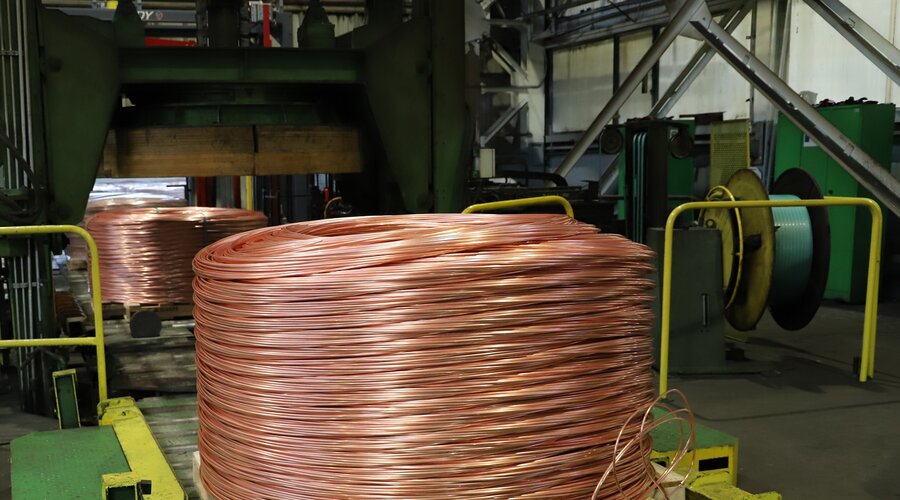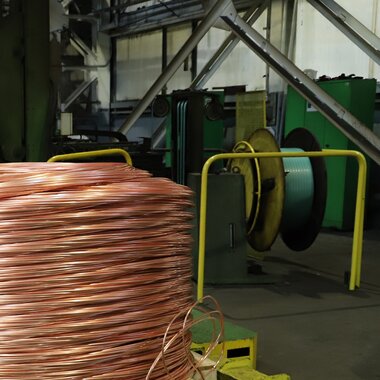KGHM’s green smelter has produced 8 million tons of copper wire rod
The “Cedynia” Copper Smelter, which is celebrating its 45th anniversary this year, has just produced 8-million tons of Cu-ETP wire rod. This is one of KGHM’s main sales products. The smelter, which is located in Orsk, is developing its production and environmental projects - electromobility or energy from renewable sources.
The “Cedynia” Copper Smelter, a division of KGHM, is the largest copper processing plant in Poland and one of the four largest copper smelters in Europe. Initially, the “Cedynia” CS produced wire rod with a diameter of 6.35 mm, and now - with a diameter of 8 mm.
Production at the “Cedynia” CS began on May 9, 1979. It took the smelter’s workers 11 years to produce the first million Cu-ETP wire rod. This value was reached in September 1990. KGHM’s division in Orsk is a modern rolling mill that processes electrolytically refined cathode copper produced at the Głogów Copper Smelter and the Legnica Copper Smelter into copper wire rod and oxygen-free copper wire of the highest quality. At the same time, these are the most processed copper products offered by KGHM that meet the expectations of demanding customers.
“The ‘Cedynia’ Copper Smelter has two reasons to celebrate.. This KGHM’s division is celebrating its anniversary, and its high production volume confirms its efficiency and reliability. The company is a guarantee of security of supply of products necessary for the global energy transition. We take a responsible approach to the challenges posed by the world. We are aware of the important role we play in supplying the raw materials necessary for energy production, especially in the context of the growing importance of sustainable sources,” said Tomasz Zdzikot, the CEO of KGHM Polska Miedź S.A.
Copper wire rod is produced in the process of continuous melting, casting, and rolling. The raw material used in this production cycle is mainly copper in the form of cathodes. The wire rod and wire come from processes carried out on the Contirod and Upcast lines. An additional product of the “Cedynia” CS is copper granules, which are made from the company’s own products. The process of their production is almost maintenance-free and, which is especially important, does not generate waste, dust, or unnecessary particles.
The “Cedynia” Copper Smelter is called a “green smelter” precisely because of its low environmental impact and its extremely picturesque location - it is surrounded on all sides by meadows, fields, and forests. Near the smelter there is the “Orchid Scarp” Nature Reserve and the “Oder River Marshy Meadows” Natura 2000 Areas.
Copper wire rod with a diameter of 8 mm characterized by a high level of conductivity is used in the cable industry for the production of conductive copper conductors in power cables, specialty cables and wires, enamel cables, electrical wires and cords, and wires for electronics. The wire rod produced at the “Cedynia” CS can be drawn in a wide range of diameters. All in all, the smelter’s products are used in a wide range of industries, including energy, chemicals, construction, automotive, telecommunications, household appliances, and the nuclear industry.
The “Cedynia” CS is located in Orsk in the Rudna Commune. It began production 45 years ago with the commissioning, based on the Belgian Contirod technology, of a modern continuous copper melting, casting, and rolling line with an annual production capacity of about 100,000 tonnes. Between 1994 and 2004, with the growing demand of European markets for high-quality copper wire rod, the Orsk plant’s production more than doubled and in 2007 it exceeded 250 thousand tonnes. New products have also been added to its sales portfolio. In 2006, a new installation for the production of oxygen-free copper wire, based on the Upcast technology, was put into operation, expanding the plant’s production capacity by 15,000 tonnes of copper per year.
Since 2009, the “Cedynia” smelter has also been producing granules from wire rod and wire. In order to increase their production, a dedicated building was put into operation in 2019. Today, the plant is a modern rolling mill and foundry producing copper wire rod and oxygen-free copper products. The semi-finished products in the form of copper cathodes come from smelters in Legnica and Głogów.
The “Cedynia” Copper Smelter holds certificate that confirm that it meets the highest global production standards in environmental, social, and management terms in the production of processed products in the form of wire rod, oxygen-free copper wire, and low-alloy copper wire.
For many years, the “Cedynia” Copper Smelter has also been conducting environmental projects. The division operates electric forklifts and electric cars. The smelter has also set up a renewable energy facility to generate energy for electric vehicle charging stations. These measures increase the share of environmentally friendly transportation in the smelter’s work and contribute to the creation of work zones that are free from noise and exhaust fumes. No less important is the reduction of the costs associated with handling of materials. Further investments in this area are planned.
Interesting facts:
The total length of the wire rod produced at the “Cedynia” CS over less than 45 years is more than 18 million kilometers. That is 454 circumnavigations of the globe, or covering the path from Earth to the Moon 47 times.
The 8 million tons of copper in the form of wire rod represent nearly 1.7 million coils. It took 338,000 trucks to transport them to customers.
Within 1 second, the wire rod in the pickling tube is simultaneously pickled and cooled from 550 to 60 degrees Celsius. During that time, it moves with the speed of 100 km/h.
Every 6.5 minutes, a wire rod coil weighing 4.8 tons comes off the production line. This translates into almost 220 coils per day.








